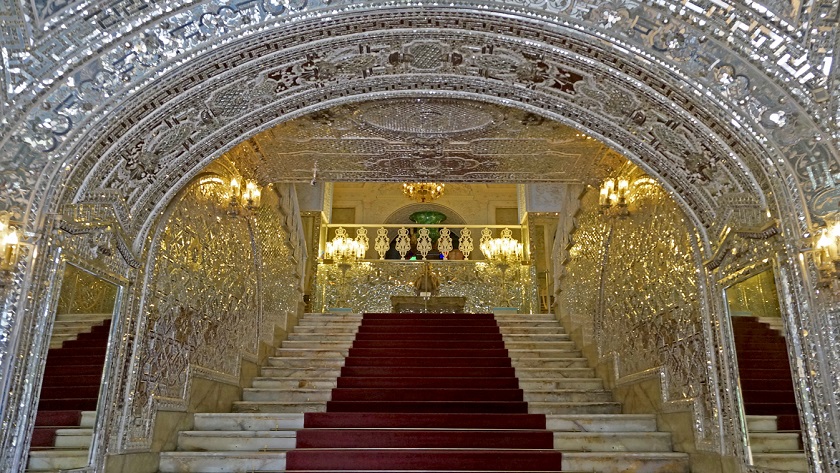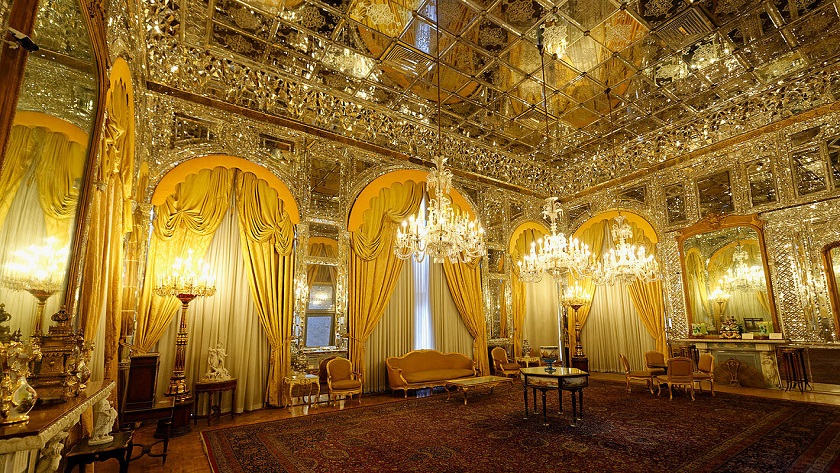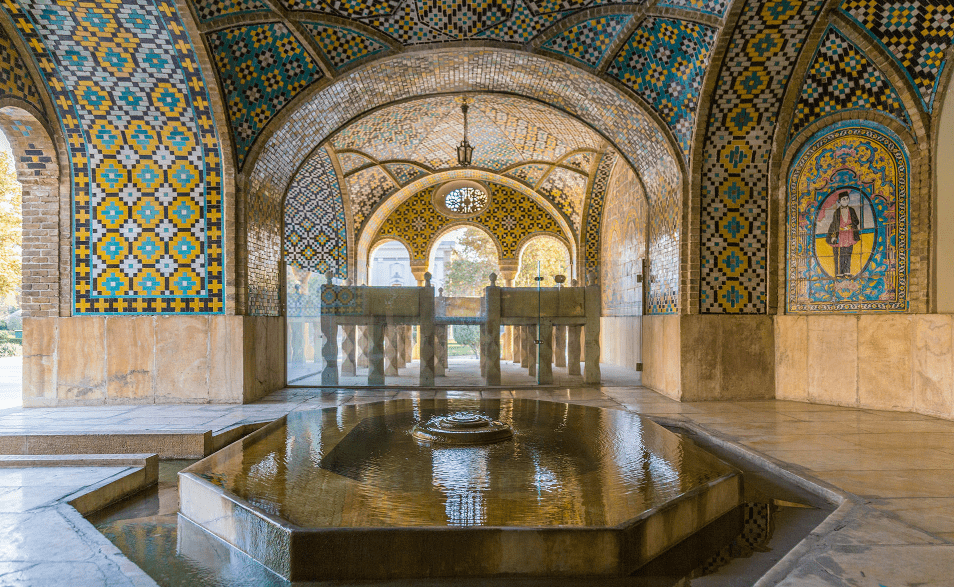Iran Press/Iran news: The resplendent Golestan Palace, a UNESCO heritage site, is a masterpiece of the Qajar era, embodying the successful integration of earlier Persian crafts and architecture and later ones. The walled Palace, one of the oldest groups of buildings in Tehran, became the seat of government of the Qajar dynasty, which came into power in 1779 and made Tehran the capital of the country.
 Entrance to Golestan palace embellished with exquisite mirrors
Entrance to Golestan palace embellished with exquisite mirrors
When Agha Mohammad Khan in 1779 came into power, he chose the Golestan Palace complex as his palace and administrative center. The next Qajar king, Naser al-Din Shah was crowned in the Imarat-Takht-e Marmar in 1848. In the next fifty years of his reign, he made many modifications to Golestan Palace. During the Pahlavi era (1925-1979), Golestan Palace was used for formal royal receptions as well. The coronation of Reza Khan in 1925 and that of Mohammad Reza Pahlavi in 1941 took place at this palace.
 Golestan Palace was the political center of Iran as Tehran became capital
Golestan Palace was the political center of Iran as Tehran became capital
Historical background:
The current Golestan Palace is the remains of Tehran’s Historical Citadel (Arg), which was constructed at the time of Shah Tahmasb I during the Safavid dynasty, around 500 years ago. The palace was reconstructed by Karim Khan Zand and was selected later as the venue of the royal court and residence by the Qajar Kings.
 Traditional Persian elements embellish the palace
Traditional Persian elements embellish the palace
The oldest buildings in the Golestan complex are Marble Throne Iwan (Iwan-e takht-e Marmar) and Khalvat-e Karimkhani belong to Karim khan Zand period. The palace has been mostly extended during Qajar era and used as the residence of Qajar kings.
 Golestan palace played a significant role during its history
Golestan palace played a significant role during its history
The palace pavilions then built by Fath Ali Shah were in turn largely torn down during the extensive and lengthy construction program (1867—92) of Naser al-Din Shah, although sections were saved: the Talar Divan Khaneh or Audience Chamber of two main the Marble Throne (Takht-e Marmar) and the Emarat-e Badgir (Wind Tower or windcatcher) in the south.
 Mirror hall at Golestan Palace mesmerizes visitors
Mirror hall at Golestan Palace mesmerizes visitors
The Safavid rulers chose Tehran as one of their places of residence, building a defensive wall and laying the foundation for a small palace and audience chamber, none of which exist today. The earliest surviving structures of the Golestan palace date back to Karim Khan-e Zand, the founder of the Zand dynasty, who intended to make Tehran his capital, and commissioned the building of an audience chamber known as the Divan Khana, (later transformed into the Takht-e Marmar), as well as the Khalvat-e Karim Khani.
 Visitors are astonished by the great beauty of Iranian art used in this palace
Visitors are astonished by the great beauty of Iranian art used in this palace
The Golestan palace was further modified during the 50-year reign of Fath-Ali Shah’s great-grandson, Nasser-al Din Shah, the fourth ruler of the Qajar dynasty. Nasser al-Din Shah was the first modern Iranian monarch to formally visit Europe, initially in 1873, then in 1878 and 1889. It was during these trips that the monarch was exposed to European Neo-Classicism, a style of architecture that influenced many of the buildings that were to become part of the Golestan Palace.
 Elements of Persian paradise and architecture are abundantly used here
Elements of Persian paradise and architecture are abundantly used here
During the Pahlavi era, a number of Palace buildings were destroyed on the orders of Reza Shah Pahlavi to make way for the development of a modern city. However, the Golestan Palace was still used for formal royal receptions, most notably the coronations of Reza Shah and Mohammad Reza Shah, the two Pahlavi sovereigns.
Related article: Tehran's Weekend: Golestan Palace, remains of historic Tehran old fort citadel
Golestan Palace Architecture:
The Golestan Palace is an outstanding example of Qajar art and architecture and a source of inspiration for Iranian artists and architects to this day. It exemplifies the architectural and artistic achievements of the Qajar era and the co-existence of Persian and European architectural elements.
 The gorgeous ceiling of the palace demonstrates attention to details
The gorgeous ceiling of the palace demonstrates attention to details
Shams al-Emarat Tower, once the tallest building in Tehran
Shams al-Emarat (Edifice of the Sun) Tower is one of the historical monuments of Tehran, related to the Qajar period and one of the most prominent buildings in the Golestan Palace.
 Shams al-Emara offers an outstanding example of Qajar art and architecture
Shams al-Emara offers an outstanding example of Qajar art and architecture
Shams al-Emara has five floors and 35 meters high, which at the time of construction was the tallest building of that period in Tehran, and was the first building to use metal in its structure.
Shams-al Emarat Towers (Edifice of the Sun), is a UNESCO World Heritage Site.
Related article: Persian Garden; What Iran is known for
Marble throne (Takht-e Marmar)
Heading in a clockwise direction around the courtyard from the ticket office, a long reflecting pool leads to the Takht-e Marmar (Marble Throne Verandah), a mirrored, open-fronted audience hall dominated by a magnificent throne.
 Marble throne at Golestan palace
Marble throne at Golestan palace
Made in the early 1800s for Fath Ali Shah (r 1797–1834), the throne is constructed from alabaster mined in Yazd and supported by carved human figures. This hall was used on ceremonial occasions, including the Napoleon-style self-coronation of Reza Shah in 1925.
Related article: Tehran's weekend: Shams al-Emarat Tower, once tallest building in Tehran
Khalvate-e Karim Khani
The gorgeous Khalvate-e Karim Khani (Karim Khan Nook), all that remains of a 1759 structure that served as the Tehran residence of Karim Khan Zand (r 1751–79). But it was Nasser al-Din Shah who enjoyed this elevated terrace most, smoking hookah and perhaps contemplating his next asset sale as qanat (underground channel) water bubbled out of the marble fountain nearby. His marble tombstone now stands on the terrace.
 Khalvat Karim Khani favorite spot of Naser al-din Shah
Khalvat Karim Khani favorite spot of Naser al-din Shah
Salam Hall (Talar-e Salam)
This is the only hall that was originally designed to be a museum. However, its usage changed to a reception hall in the presence of the king. The ceiling and walls of the hall, decorated with plaster molding, are offering extraordinary Golestan Palace architecture. Golestan Palace cinema will be constructed near this hall as well.
 The former reception hall is now a grand museum
The former reception hall is now a grand museum
Former Palace; now a Tourist attraction
Golestan Palace in Tehran is one of the most spectacular places to visit in Iran. This great palace is a fine example of Persian art, history, and architecture. It is a valuable gem sitting in the heart of Tehran carrying memories from the Safavid era to the Pahlavis. It is the highlight of the capital and it receives many Iranian and foreign visitors on a daily basis.
Read More:
Naqsh-e Jahan Square; What Iran is known for
A ceremony to commemorate Tehran Day held at Golestan Palace
Windcatcher; What Iran is known for
Ashkan Salehian

